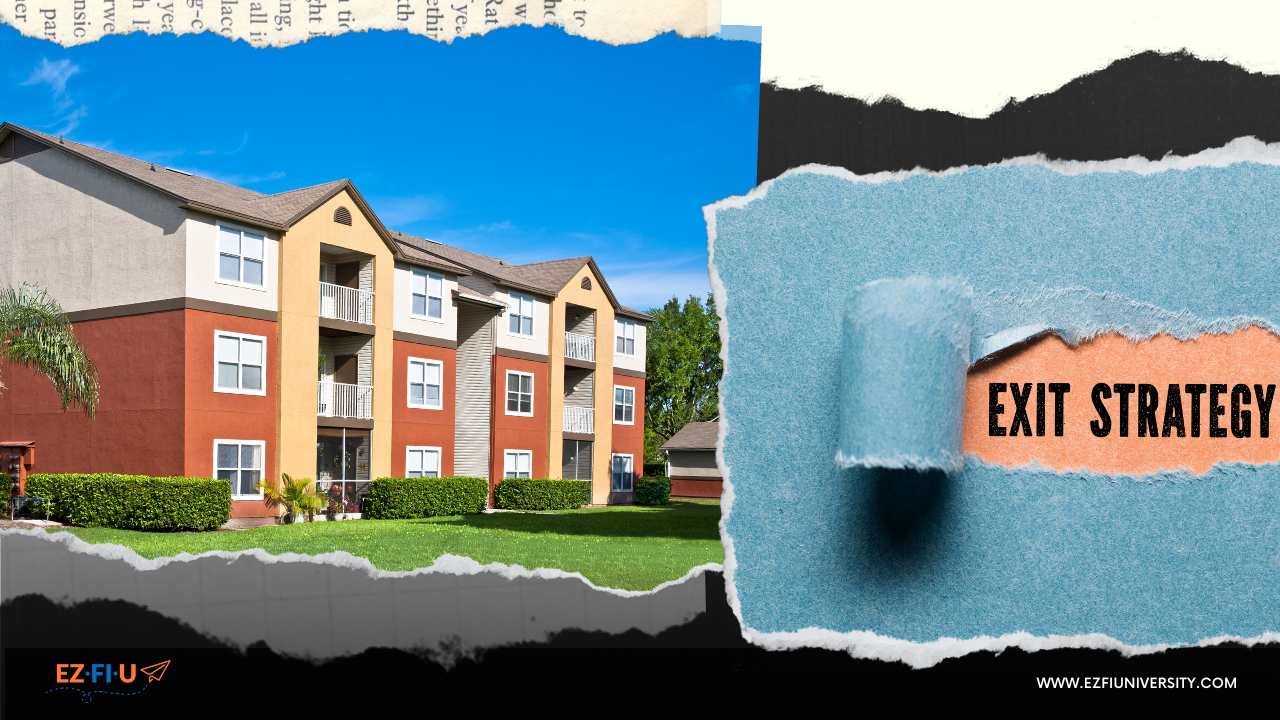What to Expect When Exiting a Multifamily Syndication Deal
When planning out how to tackle any new venture, you may have heard the phrase “begin with the end in mind.” This sentiment, introduced by Stephen Covey, encourages planning and being intentional about what you are trying to accomplish. When you begin with the end in mind, you gain clarity on what needs to be done to reach your goal and a comprehensive understanding of the big picture. This is especially important for real estate projects, as the “end” may be nearly a decade away from the initial investment. Being mentally prepared and understanding the journey ahead will help you maximize your returns and feel confident throughout the investment.
Before you jump into a multifamily real estate syndication deal as a passive investor, it’s essential to understand what to expect when the project comes to an end. The lifecycle of a deal generally happens in 7 steps, from the management team finding and underwriting a deal to raising funds, executing the business plan, and ultimately exiting the deal. We go into more detail on the full lifecycle of a deal and each step in this article.
Typically, a multifamily syndication lasts anywhere from 2 to 7 years, though there are exceptions for shorter and longer cycles. During this time, as a passive investor, you can sit back and let your money do the hard work for you. The lead syndication or sponsor team is responsible for executing the business plan and sending you regular updates.
What happens when the investment period comes to an end?
That stage is called “exiting a deal.” As a passive investor, you should know what to expect from the syndication team, the tax implications, and any decisions that need to be made at this point. This article will break down the process from the management side as well as what you should be prepared for as a passive investor.
Deal exit process from the syndicator’s POV
The lead syndicator on a multifamily investment deal is responsible for several steps at the end of a deal.
They must first decide that the business plan has reached completion and that they are ready to sell the property. This is typically determined by evaluating if the targeted profits and returns for investors have been reached, and if it makes sense to exit the deal from a market timing perspective.
From there, they will list the property for sale or cash-out refinance and return the investor’s principal investment. For the sake of this example, we will assume the property is being sold, as this is the most common scenario.
Once the property is under contract with a buyer, the syndicator will begin prepping for the exit and the transfer of the property to the new owner. This process includes tasks such as handing over financial information (rent rolls and expenses) as well as supporting the transfer of the property management staff.
With a buyer in place and an agreed-upon sales price, the syndicator will then calculate the expected return for those who invested for equity growth and are participating in the profits from the sale of the property. The syndication team will communicate with passive investors about the process and timing of these expected payments.
Deal Exit Process for Passive Investors
Assuming all goes according to plan, the syndicator will notify passive investors of their intentions to sell the property once they secure a buyer and then keep them informed about the scheduled closing date. Around this same time, you will receive an estimated expected return on your investment upon completion of the project based on your percentage of ownership of the property. The syndicator will confirm your banking details and where you’d like your payout sent. Generally, this is all handled through an online investing portal, so it’s important to ensure your banking details are correct and updated before the exit. Depending on the syndication team and the deal, you may be offered the option of rolling your funds into the next deal rather than accepting the direct deposit.
If you choose to take the full amount in cash from a sale, you will be responsible for capital gains taxes. The actual amount you pay in taxes will depend on your personal situation, such as how much in carry-over losses you have from your investment projects. It is important that you inform your CPA of your investments and the expected timing of deal exits so you can build an optimized strategy for reducing your tax burden. Many investors choose to roll their money into the next deal in order to continue growing their wealth and defer their tax liabilities to future years. You may also have the option to roll over a part of your final payout and collect the rest. Ask your syndication team or sponsor if you’re not sure what options are available, as they can change from deal to deal.
Whichever path you decide, the timing of everything, including when you receive your payout, is based on the final closing. Delays in closing can happen, and if they do, payments will also be delayed. In some scenarios, syndicators will hold back a small portion of the payouts to ensure that all closing expenses are paid. In this scenario, you will receive a slightly lower-than-expected payment followed by the additional amount at a later date. This should all be communicated by the syndication team, as transparency at this point in the process is critical. If you’re working with a good sponsor, they will be doing everything in their power to ensure maximum returns for all investors, both general and limited partners.
Alternative ending: Cashout Refinance
As an alternative to selling the property, a syndication team might make the decision to refinance the property instead. You may see this scenario occur when interest rates have dramatically gone down, and the property in discussion is producing a good cash flow. Syndicators will take advantage of this lower rate to refinance, lower expenses, and cash out their preferred return investors, who may be invested at a higher rate of payout.
In this scenario, those passive investors who invested for equity growth may either also be fully cashed out or continue to share in the profits of the deal. If you’re in doubt about which route the sponsor team will take, don’t hesitate to ask questions. Find out what the intended plan is and what scenarios are being considered so that you can be mentally and financially prepared.
Understanding preferred vs. equity returns
Some syndication teams may offer multiple ways to invest, usually described as classes. These can include “preferred return” and “equity” investment classes. Which investment option you choose at the beginning of the project depends on your individual investment goals.
Equity investing
Profits from equity investing are seen primarily at the end of the deal when the property is sold. You share those profits with the other limited partners who also bought into the deal as equity investors. Throughout the deal, the cash flow is minimal - typically around 4-6% of your principal investment annually. Investors who choose this path want to grow their wealth and are in the deal for the larger payout at the end vs. the cash flow.
Example of a projected return for investing for equity in a multifamily syndication deal
Preferred return
Investors who choose this strategy can be looked at as high-interest debt servicers. Preferred return investors earn a straight return on their principal investment at a higher rate (typically 10-12%) and do not participate in the profits from the sale. They’re still owners and therefore get to take advantage of the tax benefits; however, their payout looks slightly different than those invested for equity. At the end of a deal’s lifecycle, preferred return investors are paid out first, receiving their principal investment and a prorated amount for the current year.
Example of a projected return for investing for a preferred annual return in a multifamily syndication deal
Remember that investing in a multifamily syndication requires a long-term mindset and flexibility. A deal’s timing and strategy may change depending on the market conditions and opportunities, such as other deals. That’s why it’s critical to work with an investment team that you trust and believe has your best interests in mind throughout the project. Learn how to vet syndicators in this article and focus on building your investment philosophy so you can make the right decisions based on your goals and values.







